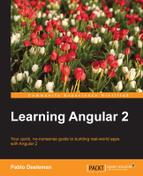In this chapter, we discussed some of the different techniques currently available for handling animations in Angular 2. First, we looked at the basic classname-based animation with CSS3 transitions with the help of the Angular built-in directives. Then, we saw how Angular provides class-based animation helpers out of the box, so we can easily implement our own transitions by following some basic conventions in our style sheets. Then, we discussed programmatically-managed animation development with the amazing animation builders currently existing in Angular 2, with some examples of how to take advantage of the Animation class callbacks to trigger actions along the animation lifecycle.
The last leg of this chapter was devoted to getting some insights about ngAnimate 2.0, which is set out to take over the previous techniques in the near future.
Our next and final chapter in the book will sum up all we have learned so far by introducing one of the most relevant requirements in modern web application development: unit testing. Angular 2 embraces common industry standards and libraries, while introducing some particular tools to turn unit testing into an enjoyable task.
